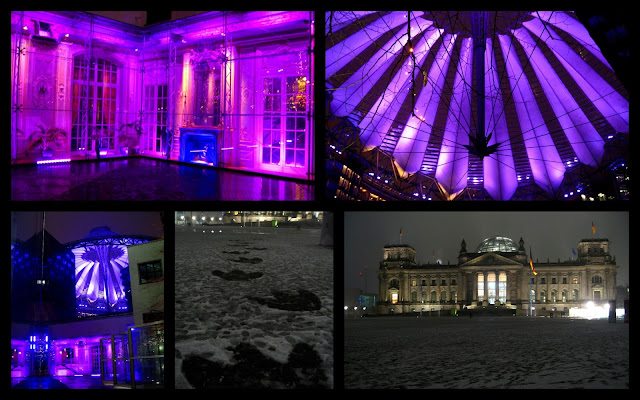The next morning, I hopped on the tram through East Berlin
to visit the Berlin Wall Memorial. East
Berlin is nice, but it’s still bleak. I
can spot a Soviet block apartment building from a mile away, and there were
plenty of them here, albeit painted in bright colors. The memorial is not exactly where you would
expect it to be. It isn’t near anything
else, but it’s free, highly informative, and even has multimedia. It was snowing profusely, but I still
listened to the recordings of people telling their stories, saw the pictures of
the 136 people who died trying to cross the wall.
 Security at the wall was intense and included a “dead zone”
between the two sides complete with razor wire, dogs, and machine guns. In the nearest subway station, there was a fascinating
exhibit on how the wall extended underground as well. A couple of the suburban train lines passed
under wall and back so the stations in East Berlin became ghost stations where
trains never stopped. Unfortunately this
also meant that the rails in these areas were not maintained and sometimes
trains derailed. There were also armed
guard stations on the platforms and tunnels were bricked up to keep people from
using the underground to escape to the West.
Security at the wall was intense and included a “dead zone”
between the two sides complete with razor wire, dogs, and machine guns. In the nearest subway station, there was a fascinating
exhibit on how the wall extended underground as well. A couple of the suburban train lines passed
under wall and back so the stations in East Berlin became ghost stations where
trains never stopped. Unfortunately this
also meant that the rails in these areas were not maintained and sometimes
trains derailed. There were also armed
guard stations on the platforms and tunnels were bricked up to keep people from
using the underground to escape to the West.
 Security at the wall was intense and included a “dead zone”
between the two sides complete with razor wire, dogs, and machine guns. In the nearest subway station, there was a fascinating
exhibit on how the wall extended underground as well. A couple of the suburban train lines passed
under wall and back so the stations in East Berlin became ghost stations where
trains never stopped. Unfortunately this
also meant that the rails in these areas were not maintained and sometimes
trains derailed. There were also armed
guard stations on the platforms and tunnels were bricked up to keep people from
using the underground to escape to the West.
Security at the wall was intense and included a “dead zone”
between the two sides complete with razor wire, dogs, and machine guns. In the nearest subway station, there was a fascinating
exhibit on how the wall extended underground as well. A couple of the suburban train lines passed
under wall and back so the stations in East Berlin became ghost stations where
trains never stopped. Unfortunately this
also meant that the rails in these areas were not maintained and sometimes
trains derailed. There were also armed
guard stations on the platforms and tunnels were bricked up to keep people from
using the underground to escape to the West.
I took a quick side trip to see the Berlin Synagogue, which
wasn’t that exciting since you can’t go inside.
From there, I passed back through Brandenburger Tor to visit the Memorial
to the Sinta and Roma killed in the Holocaust.
I then visited the Memorial to the Murdered Jews of Europe. It is a huge memorial that consists of 2,711 concrete blocks of various heights in a sloping area. It would be a scary place at night. Underneath the memorial is an information center. It gives a history of the Holocaust and documents victims’ names and stories.
I then visited the Memorial to the Murdered Jews of Europe. It is a huge memorial that consists of 2,711 concrete blocks of various heights in a sloping area. It would be a scary place at night. Underneath the memorial is an information center. It gives a history of the Holocaust and documents victims’ names and stories.
Next up for the day was Checkpoint Charlie. There is a recreation of the checkpoint
complete with the sign “You are now leaving the American sector.” Unlike my dad, I crossed the line without
having to bribe a communist official in order to stay out of jail. I also visited the Black Box Museum on the Cold
War.
Lastly, I went to the Topography of Terror Museum. It is located on top of the ruins of the
Gestapo headquarters and has an outdoor exhibit that shows the ruins of prison
cells. Inside there is a detailed exhibition
on the history of the Nazi regime. It is
a little heavy on reading, but it’s very good and free. :)
I wandered through Potsdamer Platz to see the Sony
Center. After WWII, the buildings in the
area were mostly destroyed and then it became part of the Berlin Wall dead
zone. After the wall fell, it was
developed into an entertainment and shopping district. The Grande Hotel Espianade Breakfast Room
remains can also be seen behind glass and lit up in bright colors.
Lastly, I went to take a picture of the parliament building
at night. It was lovely, but more
importantly someone was having a bit of fun and had stamped huge footprints in
the snow. It was nice to have a little bit of whimsy
after a day of hard core, rather unhappy history.



No comments:
Post a Comment